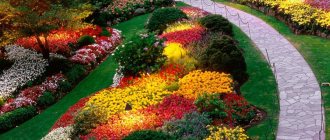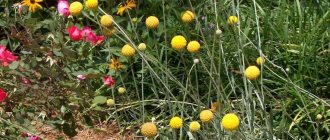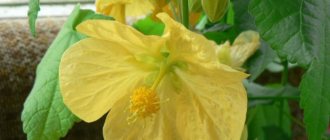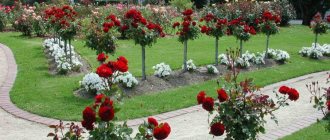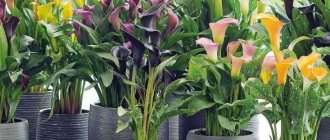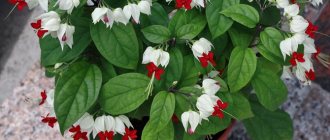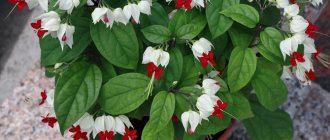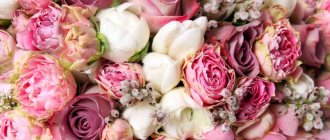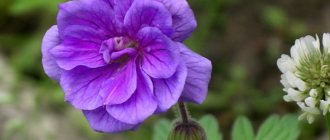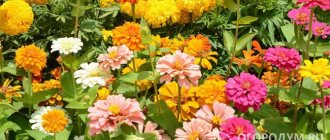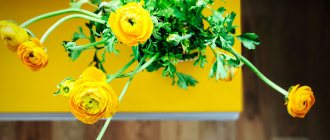Guidelines for choosing plants
All flowers growing in open areas are divided into 3 groups:
- annual;
- two-year-old;
- perennial
The first includes crops that can completely overcome all stages of life in one season. They develop successfully, decorate inflorescences, pollinate and bear fruit. And in the fall they bear seeds and disappear forever. Despite this, annuals are very popular with designers. The wealth of varieties makes it possible to create unique compositions every year.
After flowering, annual crops can be removed and a new flower bed can be arranged.
In biennial plants, buds appear only in the next season. Some specimens live longer than expected, which is very welcomed by gardeners. However, perennials are considered the most valuable “economy”. They retain their original decorative effect for decades. Most perennials have leaves and branches that die. The underground part renews vegetation as soon as suitable conditions are created. To choose the right flowers for your flower bed, you need to know them. We open and leaf through the “book” of bright plants for the garden.
Annual blue flowers for the garden
In summer, blue flowers fill our gardens with bright splashes of blue or blue. The deep blue tones of flowering plants give them a sense of serenity. What can you choose from annual flower crops for planting in a flower garden?
Evolvulus
Quite rare in our area are low blue flowers for flower beds with a true blue tint. The groundcover Evolvulus looks great on soft grey-green foliage that forms a small mound.
Ageratum
A compact plant 20-35 cm high. It blooms with small flowers collected in spherical or umbrella-shaped inflorescences. Flowering continues from June until frost. Faded inflorescences do not spoil the decorative appearance of flowers. Ageratum is propagated by seeds and cuttings. Used to decorate flower beds.
Calibrachoa
This petunia analogue is relatively new, first becoming available to home gardeners in the 1990s. Advances in breeding have led to a wider range of colors and larger patterns. One of the most versatile annual plants, calibrachoa can be added to any floral arrangement.
Place two tall ceramic vases near the entrance to your home and fill it with vibrant blue flowers to wow visitors. Decorate gazebos and porches with hanging baskets filled with your favorite flowers.
Violet or Pansy
The genus Viola has more than 500 different species, including annual and perennial crops. Varieties grown as garden varieties are mostly annuals with small flowers.
Many will sow themselves and give you years of joy. There is an incredible variety of colors and patterns available for Pansies today, including blue ones.
Aster
Annual species of aster vary in the shape of the bush and the structure of the inflorescences and flowers. They come in low, medium and high. The main stem of the plant is straight and quite strong. Stars reproduce only by seeds. Well-ripened seeds can remain viable for up to 3 years. For early flowering, aster seeds are sown in a greenhouse in mid-March.
cornflower
A durable and persistent flower, which, despite its external fragility and sophistication, easily tolerates cold, wind and prolonged drought. The perennial plant begins to bloom in May, but does not like it for a long time - until mid-June. The flowers are small, in mountain varieties they can reach 15 centimeters in diameter.
Sage or Salvia
Typically blooming from late spring to fall, salvia thrives in dry conditions and appreciates free-draining soil. With regular pruning, sage can bloom from late spring until the first frost.
The variety of colors, sizes and long flowering time make salvia an ideal addition to perennial borders, even when used as an annual.
Petunia
This crop is often grown as an annual. There is a wide variety that may differ in shades. Most often in the garden there are varieties with blue flowers. They are planted to decorate flower beds and borders.
The height of plants can reach half a meter. The stems extend along the surface of the soil. The flowers are funnel-shaped. Abundant and long flowering. Reproduction occurs by seeds. They can be sown in a greenhouse or directly in a permanent place.
bright flower
Nemophila (American forget-me-not)
A plant with highly branched, pubescent stems and widely bell-shaped flowers. Blooms profusely, but not for long. Nemophila is a rather unpretentious plant. It loves humidity and does not require much heat. Tolerates shade, prefers loose, slightly alkaline soils. Used as a ground cover plant.
Nemesia
Native to South Africa, this perennial is grown as an annual and used to decorate borders and rocky areas. Nemesia forms a “carpet” 25-30 cm high and blooms from June to August. Propagated by sowing seeds in greenhouses in February-March, and seedlings are planted in open ground in May.
Blue indoor flowers
People have long noticed that the color of plants, namely their leaves and flowers, have different effects on a person’s mood and well-being. The color of the flower expresses the energy of the indoor plant.
What does a plant with blue flowers bring into the house? Blue color will give seriousness, i.e. such a flower would be appropriate in a schoolchild’s room. Blue flowers convey tenderness and sentimentality, i.e. they would be appropriate, for example, in the bedroom. But...Beware! You can get the opposite effect, because this color is also symbolized with longing. To avoid the negative impact of blue, combine it with white or, for example, orange colors. All you need to do is purchase a brightly colored flower pot, and your indoor plant will become an additional source of joy!
Three popular plants with blue flowers
Indoor hyacinth flowers are known for their inflorescence - about thirty bell-shaped flowers are located on a leafless peduncle. They smell unsurpassed and bloom for about three weeks.
How to care for home hyacinth? He should be given the brightest place in the room. Direct sunlight should be avoided. This bulbous plant requires moderate watering. Between waterings, it is necessary to arrange mandatory drying of the soil. After the flowers wilt, stop watering. Indoor hyacinth flowers need to be fed once every two weeks.
Streptocarpus photo
Streptocarpus flowers were brought to us from South America. The beauty of their flowers resembles an orchid, but caring for them is much easier. The plant needs a warm and bright place. It will also tolerate shade, but then it will not bloom profusely. They contain streptocarpus in the summer at a temperature of + 250 C. The optimal winter temperature is + 12 +140 C. In summer, streptocarpus flowers need abundant watering; in winter, you should wait until the earthen clod dries completely. The air near the plant must be sprayed periodically, making sure that moisture does not get on the leaves.
Indoor fuchsia flowers bloom most often in summer. Brokwood Joy, Deep Purple, Golden Anniversary - ampelous fuchsias with a blue skirt. The plant should not be overheated or placed in direct sunlight. The optimal temperature is 18-220 C. To avoid overheating the roots of the plant, it is advisable to use indoor pots of light shades. Do not move the flower frequently. If an indoor fuchsia flower has completely shed its leaves, it means it needs rest and peace. Provide it to her. Place the plant in a cool place and greatly limit watering.
Fuchsia blue photo
Methods of propagation of the above plants, as well as possible difficulties in caring for them, are given in the table.
| Flower | Reproduction | Difficulties of care |
| Hyacinth | Daughter bulbs | Does not tolerate stagnant water |
| Streptocarpus | Leaf cuttings or seeds | Practically none, disease resistant |
| Fuchsia | Shoots are taken from the mother plant (about 7 cm) | Susceptible to spider mites, aphids, whiteflies |
komnatnye-tsvety.ru
Biennial plants with blue flowers
Biennials are plants that achieve ornamental value in their second year of cultivation. Most of these crops form a rosette of leaves only in the first year. Some of them may bloom, but very weakly. In the second year, the plants develop flowering shoots, bloom profusely and produce seeds.
Biennials reproduce by sowing seeds in April-May, from which seedlings are grown and planted in a permanent place in August-September of the first year. Most of these plants are also capable of vegetative propagation.
Viola
People call this flower “pansy”. Herbaceous plant of low height. The bushes are compact, no more than 30 cm high, the leaf blades have a rich green tint.
Each flower has 5 petals. In cross section, the flowers reach 4-6 cm, depending on the variety. If you plant the giant varieties, they will produce flowers about 10cm in diameter and their petals will have wavy edges. Reproduction occurs by seeds.
Rich flower
Forget-me-not
A low-growing perennial flower garden that will delight the eye all year round, in spring and summer. Forget-me-nots bloom and grow in shady places, in fertile soil soaked in liquid fertilizer. Sowing begins at the end of April, at a distance of 10-20 centimeters from each other, while the bushes are buried deep into the ground. Lack of water and frequent transplants are painful.
Perennial plants with blue flowers
Perennial flower crops develop and bloom in one place for several years. Most often they bloom in the second or third year of life. They reproduce both by seeds and by dividing the bush. These flowers are used in landscape design in single plantings and group compositions. Many of them hibernate outdoors.
Aquilegia
This plant also goes by the names: eagle and columbine. Reaches a height of 40 to 80 cm, has overgrown bushes and single or double flowers with spurs. Aquilegia blooms in May-June. Grows well in any garden soil, both in bright and semi-shaded areas. Mature plants do not tolerate transplantation well. Columbine grows in one place for 3-5 years. Propagated mainly by seeds, less often by dividing the bush.
liverwort
This is a hardy plant with leathery leaves collected in a bunch. Peduncles grow up to 10 cm in height. Liver requires clay soil with humus, frequent watering, and a shady or semi-shady place. The plant propagates by dividing the bush or by seeds.
Mordovnik
The globular flowers of the face attract a beautiful blue hue. Large, deeply dissected leaves are dark green above, lighter below. The plant is suitable for decorating landscape compositions and drawing bouquets of dried flowers.
Delphinium
This is a tall plant, growing up to 2 m. Delphinium has thin stems with pyramidal inflorescences. Flowers with a diameter of 3-7 cm can be single or double. Flowers have spurs on their backs. This feature gave the plant its second name - spurs.
Delphinium blooms in June-July, sometimes again in autumn. The flowers are odorless. The plant prefers calcareous soils and is well fertilized with humus. Easily propagated by sowing seeds, cuttings and dividing roots. Cut inflorescences remain decorative in water for up to 10 days.
Bell
A delicate and fairly common garden plant that decorates the garden for 15 to 90 days (depending on conditions and variety). They prefer sunny areas (with direct rays), but can also grow in partial shade. It is important to avoid standing water and weeds in the surrounding area. Otherwise, the plant does not require serious maintenance.
Agapanthus or African lily
The umbrella inflorescences of this plant complement the garden composition in flower beds or along sidewalk paths. The inflorescences themselves consist of small bright blue flowers. The plant blooms profusely, but not for long - from June to July. Loves sunlight and does not tolerate drought. In areas with cold winters, it is recommended to dig up the bulbs and move them to a warm room for wintering.
Lupine / Lupinus
Mostly one species is grown in gardens: multileaf lupine (Lupinus polyphyllus). A perennial plant up to 120 cm tall, the flowers are collected in multi-flowered racemose inflorescences 30-35 cm long. It blooms in June for 20-30 days. In its natural form the flowers are blue, but cultivars have been developed with red, white, pink, yellow and orange single or bi-color flowers.
Multileaf flower lupine
Of course, the list of plants with blue and blue flowers can be further supplemented and expanded: these are small bulbs (Scilla, Pushkinia and Muscari), these are annuals (asters, petunias), these are also perennials that are not included in our list. We are waiting for your suggestions to expand the list. Write your candidates in the comments.
Geranium / Geranium
Several flowering varieties are of the geranium type. The most fragrant is the Himalayan or large-flowered geranium. Its height is 50 cm. Geranium blooms from May to June and feels most comfortable in partial shade.
.
Veronica dubravnaya
If you want your garden to be full of beauty and grace, plant veronica in your garden. This flower is characterized by blue-blue flowers.
it is easy to care for and can also grow in any area. In the sun's rays, bright flowers look even more aesthetically pleasing.
Looks aesthetically pleasing in the garden
Scabious
This plant is 50-80 cm high with oblong leaves collected in a basal rosette. It blooms from July until frost, grows well in soils fertilized with humus. Prefers open and sunny places, reproduces by dividing the bush and seeds.
Eryngium (eringium)
This beautiful plant prefers hot spots and dry sandy soils. Erythematosus is captivating with its elegance: the blue flower heads are adorned with dissected silver-gray upper leaves. The plant reaches a height of 60-80 cm and blooms in June-August.
Creeping survivor
This plant is frost-resistant and drought-resistant. It can be planted in all types of soil. The peculiarity of this culture is that the tenacious one grows quickly, filling the bald spots in the area.
Persistent flowering begins in late spring and continues until June. Despite the fact that the inflorescences on the bushes last only a few weeks, they will harmoniously decorate your area.
Hardy plant
Erigeron petalata
This unpretentious perennial will not cause any problems for the gardener. It propagates easily and can bloom in one place for 5 years without losing its beauty.
If you want to liven up a dull corner of the garden, then you should plant a small erigeron petal. Fluffy inflorescences combine perfectly with other representatives of the flora, creating a colorful composition.
Brunner
A perennial plant characterized by large leaves located in the root part. The flowers are bluish. The inflorescences are weak.
Reproduction occurs by seeds or division of roots. The procedure is carried out in spring or autumn. The culture needs good moisture. Prefers sunny areas, but can also grow in partial shade.
Broad bell or Platycodon / Platycodon
The plant is 40-80 cm tall, with oval-elliptical serrated leaves and sharp tips. Short bell-shaped flowers with a diameter of 5-7 cm are located on the tips of the shoots in panicle inflorescences.
Platycodon is sensitive to fertilizers, prefers clayey, slightly acidic soils with a sufficient content of humus and a mixture of sand. Propagated by autumn sowing of seeds. After planting it blooms in the third year.
Globularia (globularia)
A herbaceous perennial plant with long leaves collected in dense basal rosettes and stems 5 to 30 cm high. Globularia is perfect for landscaping rock gardens and alpine slides. Flowers without fragrance.
Meconopsis
This perennial plant is also called Himalayan or Tibetan poppy. It is distinguished by its unusual blue coloring of flowers. Meconopsis is native to the highlands of India, China, Burma, Bhutan and Nepal, but has long been widespread throughout Europe. The genus has more than four dozen species, including miniature flowers up to 15 cm tall and powerful two-meter plants.
Subulate Phlox
This creeping perennial forms continuous flower cushions that can become a real decoration of the garden. Subulated phlox is a dwarf form.
Looks great on ridges, edges, rock gardens and along paths. Awl-shaped phlox is used in flower beds as an independent plant and in combination with other flower and ornamental crops.
Kermek
The flower is called statice. The plant has an attractive appearance, so it will beautifully decorate a flower bed. It can be used to create bouquets.
The stems are heavily pubescent. Their height reaches 0.8 m. The flowers have a rich blue tint, but there are varieties with other tones.
Linen
This plant is often used in the production of natural materials. Flax can also be planted as a decoration for the site. Flowers can be of different shades (red, purple and yellow). However, the most popular varieties are those with blue inflorescences.
The crop is propagated by seeds. It should be planted in well-lit areas.
Anagallis
This crop is considered a field crop. Initially it was not popular with gardeners. Subsequently, breeders developed several more varieties, distinguished by deep blue flowers. The bushes evenly and densely cover the soil surface. The height of the plant does not exceed 20 cm.
It is not recommended to over-water the anagallis, as this can lead to rotting. Reproduction occurs by seeds. They need to be planted immediately in mid-spring in a permanent place. Flowering will be bright and abundant if the plant is planted in full sun.
low growing plant
Aconite glomerulosa
An elegant plant with an average height of 80 cm. Glomerular aconite (Aconitum napellus) is covered with large blue panicle inflorescences. Used for small group plantings.
Perennial is a winter-hardy plant. It can grow in one place for up to 8 years.
Gladiolus
A genus of perennials, including numerous species. A popular variety with blue flowers is Blue Mountain).
For gladioli shoots to bloom, they need nutritious, well-warmed soil by the sun.
Depending on the period and environmental conditions, the gladiolus produces purple-blue flowers. Height reaches 120 cm.
Iris
The iris flower has six petals arranged in two circles: three on the outside and three on the inside. The outer petals are curved down, while the inner petals are raised up and often close, which makes the flower unique. Early flowering irises bloom in the first half of May, late ones - in July.
The most common method of vegetative propagation. The plants are undemanding to soil fertility, but grow best on arable land.
Indoor flowers with blue flowers
When creating compositions on their windowsills and in mini-gardens, gardeners select plants with flowers of a certain color. As a rule, to give the room a romantic, gentle atmosphere, indoor flowers with blue flowers are planted. There are a great variety of such plants: for example, lisianthus, streptocarpus, Uzambara violet, sollia, cucumber and many others. They all have soft blue flowers and pair beautifully with cream or yellow plants.
In this article we will tell you which blue flowers take root best at home and give recommendations for caring for them. You can also see photos of blue flowers below and read their description.
Blue lisianthus flowers
Lisianthus (LISIANTHUS) has blue poppy flowers arranged in groups. There are double and non-double varieties in purple, mauve and white colors. These are upright bushy perennials, but in the nursery they are treated with retardant - a growth retardant for indoor plants. Lisianthus are difficult to keep in a room for more than one season.
There is only one species on sale - with the name on the label either Russell's lisianthus (Lisianthus russelianus) or large-flowered eustoma (Eustoma grandiflorum). Compact varieties 30-45 cm tall are offered, rather than tall varieties.
Temperature: Moderate. Keep in a cool place in winter.
Light: Brightly lit areas - some sunlight is beneficial.
Watering: Water thoroughly, then allow the soil to dry moderately.
Humidity: Spray foliage frequently.
Care after flowering: Plants are usually not preserved. Reproduction: By sowing seeds in spring or dividing plants in autumn.
Which blue flowers are most popular: streptocarpus
Streptocarpus has many hybrids, but the old variety Constant Nymph is still the most popular streptocarpus. A blue flower appears above a rosette of large leaves with enviable frequency - this plant blooms throughout the summer. It requires a shallow pot, moist air, bright light and protection from drafts and cold air in winter.
The flowers of Streptocarpus Constant Nymph are lilac with purple veins. In other varieties they are white, blue, purple, pink or red.
Temperature: Moderate - minimum 13°C in winter.
Light: Brightly lit areas, protected from direct sunlight in summer.
Watering: Water deeply, then allow the surface of the soil to dry out between waterings. Water sparingly in winter.
Humidity: Spray occasionally. Do not wet the foliage.
Replanting: Replant annually in the spring.
Propagation: Dividing plants during transplantation. Seeds can be sown in spring.
Blue Usambara violet flower
Usambara violet or Saintpaulia (SAINTPAULIA) blooms very profusely. The main advantage of this blue flowered indoor plant is its compact size and ability to produce several waves of blooms each year. Plants need stable heat, proper watering, good lighting, high humidity and regular feeding. Remove spent flowers and leaves immediately.
There are thousands of varieties of hybrid Saintpaulia (Saintpaulia hybrida) ranging in size from 8 cm to 40 cm or more. The flowers are simple, double, corrugated, two-colored and star-shaped.
Temperature: Moderate - minimum 16°C in winter.
Light: Bright light: east or south oriented window in winter - west oriented window in summer. Shade from the sun.
Watering: Keep the soil moist at all times using lukewarm water.
Humidity: Humid air is necessary.
Replanting: Replant if necessary in spring.
Reproduction: Leaf cuttings in spring.
Indoor flower with blue flowers
Clusters of sky-blue flowers (PLUMBAGO) appear in summer and fall. The vigorous growing vine can be grown on a sunny windowsill as a single plant or formed into a frame around a window. These blue flowered houseplants need to be kept in a cool place throughout the winter and early spring.
Plumbago auriculata is grown as a hanging plant or as a supported vine. Its stems can reach 1 m; They are pruned in the spring. There is a variety with white flowers (alba).
Temperature: Cool to moderate temperature; minimum 7°C in winter.
Light: Bright light with some direct sunlight.
Watering: Keep the substrate moist at all times. Water sparingly in winter.
Air humidity: Spray the foliage from time to time.
Replanting: Replant if necessary in spring.
Reproduction: By stem cuttings in autumn. Sowing seeds in spring.
Blue sollia flower
Many of the vines are giants, but the modest SOLLYA plant grows only to 1 m. In summer, bowing bell-shaped flowers of a soft blue color appear, and these are replaced by purple fruits. This blue flowered plant is one that is not easy to find, but is worth looking for.
Sollya heterophylla can be used to cover a tall ornamental foliage plant.
Temperature: Cool to moderate temperature; minimum 7°C in winter.
Light: Well lit or slightly shady area.
Watering: Keep the soil moist at all times during the growing season, but water more sparingly during the winter.
Air humidity: Spray the foliage from time to time.
Replanting: Replant if necessary in spring.
Reproduction: By stem cuttings in spring.
sadovodka.ru
Bulbous blue plants
Perennial bulbous plants in open ground are distinguished by the first flowering of all plants. Their underground part is a bulb in which nutrients accumulate and from which a peduncle develops. These plants are best planted in small bushes between ground cover perennials. All bulbous flowers dry up after flowering, their foliage dries up and gives way to neighboring plants.
Iridodictium or iris reticulum
A winter-hardy and light-loving perennial, very similar in appearance to irises. Flower coloring is mainly limited to blue and blue shades. The plant can grow in poor soil. Propagated by daughter bulbs. Iridodiction grows in one place for up to 7 years. It is used to decorate flower beds, rock gardens and alpine slides. The bulbs can be left outdoors over the winter, but it is better to dig them up annually.
Muscari
A small bulbous plant, also called mouse hyacinth, has a height of 15 to 25 cm. Muscari blooms earlier than many other plants - in April-May. They do well in sunny places, such as rock gardens. In addition to beauty and grace, muscari attracts with its unpretentiousness. They adapt very easily to different conditions.
Anemone
This plant is also called “crown anemone”. Bulbous plant. The underground part of the bush consists of small tubers. They need to be dug up for the winter and moved indoors.
The culture begins to bloom in late spring. Sowing should be done in well-lit areas or in the shade. The soil must be well moistened and fed. Therefore, it is advisable to add humus before planting.
Anemone
Scylla
A bulbous perennial, also called blue snowdrop or blueberry. Height - up to 15 cm. It is characterized by early flowering, which occurs in early or mid-March.
Perennial Scylla prefers acidic soils enriched with peat and humus
Blue snowdrops are considered sensitive to lack of light. They do not open in cloudy weather. When the air temperature drops, the stems become violently overturned.
Hyacinth
These little seedlings are the embodiment of spring and emerge from the snow on the first warm days. They are pointed green stems decorated with dense inflorescences with many blue flowers. The plants can grow in flowerbeds or along sidewalks and make great additions to the garden and a fragrant filler to the backyard.
Allium
This plant is also called “decorative onion”. The leaves are located at the roots, and the inflorescences are spherical in shape. Peduncles are tall. The height of the bushes can vary from 30 cm to 1.4 m. It all depends on the chosen variety. The culture tolerates frost well, but prefers sunny areas.
Reproduction is carried out by seeds or bulbs. Onions can be produced by self-sowing. The blue flower for the garden begins to bloom in the second year after planting in a permanent place.
This is what a decorative bow looks like
Chionodoxa
This plant is one of the first to bloom as soon as the snow melts. Its height is 10-15 cm. The flowers are collected in racemose inflorescences. Chionodoxa grows well in full sun to partial shade, but blooms first in full sun. Propagated by seeds and bulbs.
Pushkinia prolesciformes
This miniature ornamental plant is grown in group plantings in rock gardens. In nature, Pushkinia is found in mountain meadows and rocky slopes of the Caucasus and Asian countries. The plant prefers well-drained soil and open sunny places. Propagated by bulbs, pups and seeds. Can grow in one place for 5-7 years.
Plants with blue flowers: compiling a collection of indoor plants in cold colors
Indoor plants have long ceased to be treated as decoration for window sills. Magnificent plants, if properly “presented” with the help of decorative flowerpots and skillfully selected accessories, turn from green inhabitants of houses into real aesthetic accents, giving interiors completeness and harmony, emphasizing the design, creating the mood, and sometimes transforming the living space. An exhibition of indoor flowers that have moved from the windows into the room can correctly be called a collection, because each plant appears in inextricable connection with its fellows. The color palette plays an important role in the effect that such a collection has on the interior of a house or apartment.
Along with prefabricated compositions that combine many different colors, today monotonal exhibitions are becoming increasingly popular, which also have a psychological effect, acting as a tool for color psychotherapy. One of the most popular colors today that are chosen to compile a collection of indoor plants is a cool, soothing blue, which offers a wide selection of nuances and undertones of a noble color scheme. Almost everyone likes blue color. Associated with clear skies, deep lakes and endless oceans, it symbolizes the water element and carries within it smoothness, calm, stability, comfort and solitude. All shades of the blue palette - from delicate, almost imperceptible blue to ultramarine and inky violet - evoke a dreamy, relaxed mood. Despite the fact that the blue color scheme is considered primarily calming, it is no less romantic. And this effect is only enhanced by flowering plants, the shape and shades of which enhance the romantic notes. Blue- and violet-flowered plants can be found in every garden, because without them it is impossible to imagine a full-fledged harmonious design of flower beds and flower beds. And if in a flowerbed your favorite cool colors add depth and create the effect of an internal glow, then in a room they create the illusion of privacy and coolness, which is especially important on hot days.
Many of the plants that are considered the brightest blue-colored crops of garden flower beds - hydrangeas, amaryllis, lavender - can also act as pots not only on the balcony, but also in the house. They are not inferior in beauty to such classic representatives of the cold range as Usambara violets, which boast an amazing violet-blue color. In addition, magnificent bells with uniquely beautiful flowers and a special shade of ultramarine will be an excellent addition to the collection of plants with blue or purple flowers; lilac-violet, richly colored primroses; bright blue gentian; cold purple cineraria; pale lilac exakum; Streptocarpus unusual in color. Let's take a closer look at the most fashionable of them.
Eranthemum graceful is a not very popular (and completely undeservedly!) tropical shrub that grows only in a bright, diffusely lit place at a stable room temperature. It is very easy to care for and requires only moderate watering. The main pride of Eranthemum is its charming, very dark leaves and amazingly bright blue flowers.
Among the bells, you can grow in pots not only the Carpathian bellflower, but also the surprisingly cute Portenschlag bellflower and Campanula equifolia. True, the terry Carpathian bluebell variety “Thorpedo Blue Ball” will easily outshine them if placed next to it, so be careful when combining different types of these flowers with each other. When growing all bells, it is important not to dry out the soil and place them in a bright place. Plant bells in a pot immediately after purchase, without delay, because even a few hours can be disastrous for the plant. If desired, the bells can be transferred to open ground for the summer.
Primrose obconical is a subspecies of primrose, which is distinguished by soft, uneven watercolor colors of simple, almost round flowers with a wavy edge, collected in loose inflorescences on relatively high peduncles above a rosette of beautiful elongated leaves. This primrose loves fresh air and coolness, moderately moist soil, regular fertilizer and needs to be replanted after each flowering. In order to preserve the beauty of flowering, faded flowers should be plucked out immediately.
Arrange the collection on all suitable surfaces in the room - racks, shelves, tables, stands. Place some plants planted in the most beautiful pots individually (as well as large plants that belong on the floor), while others are placed in attractive groups. In particular, Uzambarian violets, Primrose obraconical, hydrangeas, and Armenian mouse hyacinth look great next to each other. A trio of the same Uzambara violet with steptocarpus and ixora also looks very good, which can even be planted in one container. But brunfelsia will only need one neighbor - moss, which will help maintain the most favorable humidity of the earthen clod and help humidify the air.
To enhance the influence and psychological effect of the color blue, be sure to plant at least a few plants in glazed ceramic pots with traditional painting in the style of British china sets (you can even use cups and saucers for planting small bulbs). White porcelain flowerpots, light-colored original troughs or buckets decorated in decoupage style are also perfect for the collection. When choosing containers for planting indoor plants, remember that cool and dark colors look better in light-colored pots. Patterns on flowerpots are welcome. Unattractive containers can be hidden by decorating with ribbons, wrapping with fabric secured with decorative cords, or braiding with dry grapevines (in particular, bells and pansies look better in this setting).
Ground cover flowers perennials blue
Climbing and climbing plants are no less decorative than standing ones. Ground cover perennials bloom in the area in blue and green at the same time due to the large number of shoots and dense foliage.
morning glory
Low growing, very climbing plant. It is a vine-like perennial with small blue flowers.
Morning glory is used for vertical gardening
Important! The plant contains toxic substances. Therefore, it is planted in places inaccessible to children and animals.
Morning glory has a long flowering period. The perennial blooms in early June and fades with the onset of the first frost.
Lobelia
Perennial herbaceous plant with small blue flowers. It is characterized by rapid growth. Pillow shape. With regular pruning, you can make the flower dome-shaped.
Lobelia needs moisture and sunlight to bloom profusely.
Height - up to 25 cm. Flowers 1.5-2 cm in diameter. Lobelia is used to decorate borders, flowerbeds and flower beds. Often planted in mixborders and rock gardens in front of tall ornamental plants.
Heliotrope
Creeping varieties are used as ground cover. The most common is marine heliotrope. Bush height up to 35 cm.
Heliotropes can be planted in both sun and partial shade.
The decorative value of heliotrope is manifested not only during flowering. It has large, dense foliage that only fades in late fall.
Aubrietta
The Blue Cascade variety is used as a ground cover plant. Perennial herbaceous plant with abundant flowering. This species is one of the evergreen plants. The foliage retains its color most of the year and blooms in early spring.
The annual growth of aubrietta reaches 20 cm
The flower is exceptionally winter hardy. Forms a lush cover on the soil surface. Flowering lasts up to 8 weeks. The foliage remains green until mid-autumn.
Periwinkle
Low-growing perennial up to 15 cm tall. It is resistant to adverse factors. Tolerates cold winters well without affecting the intensity of flowering.
Important! Periwinkles are able to reproduce by self-sowing. If this is not necessary, the pods must be removed from the flower.
Periwinkle is ideal for shady areas
The perennial is not picky about the composition of the soil. But if you plan to grow blue periwinkles for a long time, it is best to plant the flower in fertile soil.
List of blue flowers with names and photos: field, garden and indoor
Home » Plants » List of blue flowers with names and photos: field, garden and indoor
Monochrome flower arrangements always remain popular.
To decorate your garden, create an attractive bouquet or furnish your apartment with plants of the same color, you need to distinguish them by their names.
We suggest considering a list of plants that have blue flowers.
Lily leaf bell
The bell belongs to the bellflower class and is a representative of wildflowers. The bell grows in Europe, the Caucasus and western Siberia.
It can often be found in thickets and bushes near rivers. Blue bell flowers can easily be confused with field bells.
There is a slight difference between these plants - the presence of a long pistil in the lily-leaved bell.
The bell is characterized by long flowering, its stem is covered with thin leaves . In Belarus, the bell is listed in the Red Book.
morning glory
An elegant representative of garden plants, which allows you to green fences and fences with its climbing stems.
The sky-blue shades of the flower fascinate garden owners, which is why morning glory is widely used in garden landscaping.
The flower has the shape of a gramophone, its main color is blue with streaks of purple and burgundy. Morning glory is an annual plant and blooms from June until the first frost.
The stems of morning glory are climbing, densely covered with medium-sized leaves . The flower is great for disguising unsightly areas of the garden space.
Lisianthus
A plant with blue or blue flowers, intended for growing indoors . When indoors, this flower reaches a height of 35 cm.
Its flowers are grouped in groups, they have a poppy-like silhouette, and the surface is covered with terry fibers.
Fluffy flowers require constant sunlight , so it is best to place lisianthus in a well-lit window.
Do not forget about the foliage: it must be frequently sprayed with water. Lisianthus requires thorough watering, as well as moderate temperature conditions. In winter, lisianthus is kept in a cool place.
cornflower
The meadow fields of Russia are abundantly covered with this plant. It is also common in the Caucasus. Cornflower is not grown for decorative purposes; it grows near bushes, in fields and meadows.
Cornflower is considered perennial : its stem is rough and reaches a height of 1 meter. The flowers have a blue and purple hue and bloom throughout the summer.
Cornflower is widely used in medicine - it has tannins, has a diuretic, analgesic and anti-inflammatory effect.
blue cyanosis
The plant is used for ornamental gardening and also grows wild in the Caucasus, western Siberia and the European part of Russia.
The stem of the cyanosis is branched, but bare . Small leaves do not completely cover the erect plant. The blue flowers look like small gramophones.
They consist of several boxes, and the pistils protrude forward. Field species of cyanosis grow near wetlands, where humus occurs in the soil.
It can also be found on the edges, near bushes : there the cyanosis is grouped or grows individually.
Piglet auricularis
Houseplants often have fancy names, and vinica is no exception. Its blue flowers are arranged in clusters at the top of the stems, so it creates a beautiful blue crown over the pot.
The stems of the stem are creeping - they can be used to beautifully decorate window openings. In winter and spring, it is recommended to keep the plant cool.
Flowering begins in summer or early autumn. For proper growth, the pigweed must have support in the pot.
When the stems reach 1 meter, they are cut off - it is better to do this in the spring. In summer, watering should be plentiful, and in winter, sparing.
Delphinium or Larkspur
A beautiful tall plant with an erect stem, widespread in central Russia. It grows in wild fields and is also used for ornamental gardening.
The height of larkspur can reach from 50 cm to 2 m ; annual and perennial individuals are distinguished. You can admire the blue flowers from the end of June for a whole month.
Delphinium is unpretentious in garden cultivation , but it would be a good idea to install plant supports to avoid damage during bad weather.
You can grow delphinium yourself using cuttings or sowing.
Blue Lily
This name is sometimes given to the blue water lily that grows in bodies of water. Africa is considered the birthplace of the water lily; later it was brought to India and China.
This pale blue flower is widely praised in literature . The peculiarity of the lily is that it blooms on water during the daytime.
It lasts about 3 days, after which it fades. Blue water lily is not only elegant, but also healthy.
It has long been used as an antiseptic with a calming effect. If there is a pond at your summer cottage, you can grow a blue lily yourself.
Gloxinia
The plant blooms profusely with beautiful blue and white bells. It is easy to care for at home, so it is widespread among those who like to grow indoor plants.
It is suitable for diffused moderate lighting, a temperature of 18 to 22 degrees, and relatively high humidity.
In the evening the blue flower falls asleep and opens again in the morning . Gloxinia's leaves are rough, so they can retain moisture: this point should be taken into account if the plant is often exposed to the sun.
Garden and indoor plants are equally beautiful as their meadow counterparts. Blue color is designed to calm the nervous system and evoke a feeling of peace.
If you have no inclination to grow flowers, make them yourself from foamiran . They will look lifelike and delight the eye every day with their beauty and elegance.
Useful video
Share this post
- Related Posts
- Growing kiwi at home: care and planting
- What is the tallest tree in the world and where does it grow?
- The healing properties of Veselka
- Benefits and healing properties of evening primrose oil
- How to care for geraniums at home, what types are there, why do they get sick, how often to water, replant, prune?
- Choosing a pot and soil for an orchid, replanting and care, why the leaves wither and turn yellow
Add a comment Cancel reply
Ornamental shrubs with blue flowers
This group of plants decorates the garden from early spring to late autumn. The root system of shrubs penetrates deeply into the soil, and part of the soil can reach a height of several meters. As a rule, most shrubs are quite hardy.
Hydrangea
deciduous ornamental broad-leaved shrub. Its flowers are collected in large inflorescences. Hydrangea requires fertilizer and soil moisture, is light-loving, but can also grow in partial shade. The plant propagates by seeds, layering, offspring, dividing the bush, cuttings and grafting. This lushly flowering shrub looks great both in single plantings and in group compositions.
Blue hydrangea buds will add charm to any garden. It blooms for a long time, delighting with inflorescences ranging from soft blue to dark blue. Alkalinization of the soil only affects the variety of shades of hydrangea.
Many brides prefer hydrangea by including this flower in their bouquet.
Lilac
Spring is not spring without lilacs, especially without lilacs with blue, heavenly fragrant caps. Lilac varieties have been developed in different shades from lilac-blue to light blue. A bouquet of their blue flowers will amaze with its beauty everyone to whom it is presented.
Ceratostigma
This deciduous shrub is highly decorative. In summer and early autumn it blooms with blue flowers, shaped like phlox. In autumn, the leaves of the plant change their green hue to bright red, which gives it an even more attractive appearance.
Ceanothus redroot
It is difficult to find a more decorative bush than a bush so similar to lilac. The shrub is unpretentious, tolerates drought and severe frosts well.
Gorgeous hats with floral patterns can be seen from afar. It is the splendor and beauty that attract gardeners to grow this wonderful shrub.
Clematis
A wide sky-blue flower with original green leaves and long shoots that lift the flowers, highlighting them against the general background of the bush. The plant needs regular and abundant watering, systematic loosening of the soil and organic fertilizers three times a season. If you follow these rules, clematis will delight you with flowering for two months.
Ornamental shrubs
This group of plants decorates the garden from early spring to late autumn. The root system of the shrub penetrates deep into the soil, and the above-ground part can reach several meters in height. Most shrubs are usually quite frost-resistant.
Clematis
Clematis
The stems of this decorative vine reach 5-7 m in length. Flower buds form on the current year's shoots. This shrub has low soil requirements. It grows well in sunny, open places, protected from the wind, and blooms profusely. Climatis can be propagated by grafting, cuttings, dividing the bush and seeds. The plant should be covered for the winter. Flowers have no scent.
Hydrangea
Hydrangea
Deciduous ornamental shrub with large leaves. Its flowers form large inflorescences. Hydrangeas do not require fertilizers or moisture, they require light, but can be grown in partial shade. The plant propagates by seeds, layering, division, cuttings and grafting. This profusely flowering shrub looks great both in single and group plantings.
Lilac
Lilac
One of the most popular flowering shrubs. Lilacs are usually grown in gardens and parks. Valued for its long flowering period and decorative appearance. Its blooming flowers fill the entire garden with their aroma.
Hardy and frost resistant. Flower buds rarely freeze. Garden forms can only be propagated vegetatively.
Ceratostigma
Cerastostigma
This deciduous shrub is very decorative. In summer and early autumn it blooms with blue flowers, shaped like phlox. In autumn, the leaves change color from green to bright red, which gives the plant an even more attractive appearance.
Indoor blue flowers
Blue flowers for the windowsill are not limited to a couple of varieties of violets. Of course, they also deserve attention, but we found many more options!
Saintpaulia (Usambara violet)
The main advantage of this small bush is its ease of care and external elegance. The compact bush blooms in several waves a year and during the growing season forms 10-20 buds, which open brightly and are covered with contrasting green leaves. Florists recommend immediately removing faded flowers and leaves so that the plant can develop in the future.
Clerodendrum uganda
A shrub that any housewife can turn into a home vine without much effort and knowledge in the field of floriculture. The buds are decorated with small, rare blue flowers, but of captivating beauty with curly stamens. Fans often call such inflorescences butterflies for the special airiness and lightness of their petals. From the first day of planting, it is necessary to form a crown so that in the future the branches do not become lignified and begin to shed leaves; weak and thickened shoots must be pruned.
Syrian hibiscus
Housewives fell in love with this plant for its abundant and wide flowering and the aroma of vanilla, filling the room already during the budding period. With proper care, flowers can please the eye all year round. To do this, the plant needs high humidity (spraying hibiscus several times a week), twice fertilizing per season and systematic watering, which does not allow the soil to dry out more than 2-3 centimeters.
Cineraria hybrid
In spring the bush forms a small bouquet. These delicate flowers will delight you with short but abundant blooms. It is important for the plant to maintain high humidity (from 50%) and intensive supply of fertilizers to the soil during the budding period. It is also advisable not to place the pot in direct sunlight or near radiators.
Streptocarpus
A strikingly beautiful flower with dark blue petals with purple veins and a white center. The plant is unpretentious in care and can be tamed even by an inexperienced gardener. With proper watering and lighting, streptocarps will bloom from early spring to late autumn. If desired, the flowers are sprayed and supplied with fertilizers during the growing season.
Campanula
Among the people, this plant received a second name - “bride and groom”. The inflorescences are graceful blue bells with a white core, which makes the branches airy and elegant. It grows as a compact shrub and, with proper care, blooms all year round. The peculiarity of care is that the plant must be pruned every two years, otherwise it will die.
Achimenes Aquamarine
Airy and elegant flowers delight the eye and fill the room with a pleasant aroma. In winter, the plant rests without leaves or flowers and requires minimal watering and care. Some species have velvety petals with colored spots: purple, white or yellow. The plant will delight you with abundant flowering, located on the south side of the house when buds form, so it is recommended to move it from direct sunlight to an area of diffused lighting.
Lisianthus
Beautiful flowers reminiscent of roses. A special feature is the color change depending on the lighting: during the day in the sun the flowers look blue, and in the evening and on cloudy days the plant takes on a deep blue hue. For abundant flowering, it is necessary to provide bright but diffuse lighting, systematic watering and spraying.
Pig
Delicate blue flowers on a long stem delight with a pleasant aroma and long flowering. To preserve the plant, it is necessary to maintain an optimal temperature, in summer - from 17 to 24, and in winter - not lower than 15 degrees. The seedling loves light and prefers to be placed on window sills on the younger side of the house.
Primrose
Rosettes of leaves produce delicate, succulent sky-blue flowers with a yellow center. Primrose blooms from the first days of spring and is a harbinger of warmer days outdoors. The velvety petals exude aromatic notes and the foliage glows a soft green color, creating an airy aura around the entire plant.
Popular blue indoor flowers
People have long noticed that the color of plants, namely their leaves and flowers, has different effects on a person’s mood and well-being. The color of the flower expresses the energy of the indoor plant.
What does a plant with blue flowers bring into the house? Blue color will give seriousness, i.e. such a flower would be appropriate in a schoolchild’s room. Blue flowers convey tenderness and sentimentality, i.e. they would be appropriate, for example, in the bedroom. But...Beware! You can get the opposite effect, because this color is also symbolized with longing. To avoid the negative impact of blue, combine it with white or, for example, orange colors. All you need to do is purchase a brightly colored flower pot, and your indoor plant will become an additional source of joy!
Three popular plants with blue flowers
Indoor hyacinth flowers are known for their inflorescence - about thirty bell-shaped flowers are located on a leafless peduncle. They smell unsurpassed and bloom for about three weeks.
How to care for home hyacinth? He should be given the brightest place in the room. Direct sunlight should be avoided. This bulbous plant requires moderate watering. Between waterings, it is necessary to arrange mandatory drying of the soil. After the flowers wilt, stop watering. Indoor hyacinth flowers need to be fed once every two weeks.
Streptocarpus flowers were brought to us from South America. The beauty of their flowers resembles an orchid, but caring for them is much easier. The plant needs a warm and bright place. It will also tolerate shade, but then it will not bloom profusely. They contain streptocarpus in the summer at a temperature of + 250 C. The optimal winter temperature is + 12 +140 C. In summer, streptocarpus flowers need abundant watering; in winter, you should wait until the earthen clod dries completely. The air near the plant must be sprayed periodically, making sure that moisture does not get on the leaves.
Indoor fuchsia flowers bloom most often in summer. The plant should not be overheated or placed in direct sunlight. The optimal temperature is 18-220 C. To avoid overheating the roots of the plant, it is advisable to use indoor pots of light shades. Do not move the flower frequently. If an indoor fuchsia flower has completely shed its leaves, it means it needs rest and peace. Provide it to her. Place the plant in a cool place and greatly limit watering.
Methods for propagating the above plants, as well as possible difficulties in caring for them, are given in the source
https://komnatnye-tsvety.ru/sinie-komnatnye-cvety.html
podokonnik.temadnya.com
